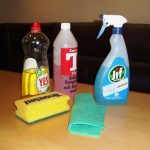 Purifying or cleansing agents, usually salts of long-chain aliphatic bases or acids, that exert cleansing (oil-dissolving) and antimicrobial effects through a surface action that depends on possessing both hydrophilic and hydrophobic properties.
Purifying or cleansing agents, usually salts of long-chain aliphatic bases or acids, that exert cleansing (oil-dissolving) and antimicrobial effects through a surface action that depends on possessing both hydrophilic and hydrophobic properties.
A cleansing agent, generally a surface active organic compound that Emulsifies the “dirt” and lowers the surface tension of the water.
A compound or mixture used to clean.
A substance capable of dissolving lipids.
A cleaning substance which removes grease and bacteria.
A synthetic cleansing agent that removes all impurities from a surface by reacting with grease and suspended particles, including bacteria and other microorganisms. Some detergents, e.g. cetylamine, are used solely for cleansing; others may be used as antiseptics and disinfectants.
Substances which cleanse the skin surface. This means that, strictly speaking, any soap, or soap like substance used in washing, is a detergent. However, the term is largely used for synthetic detergents prepared from high petroleum waxes and sulphuric acid. The commoner ones in commercial preparations are aryl alkyl sulphate or sulphonate and secondary alkyl sulphate.
